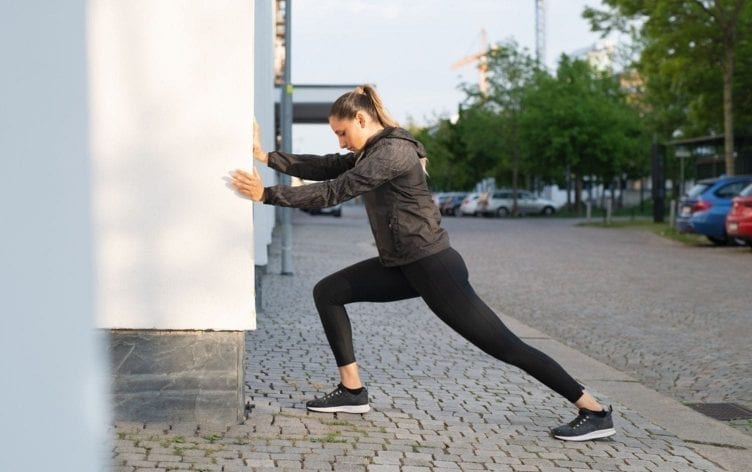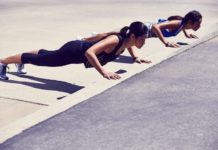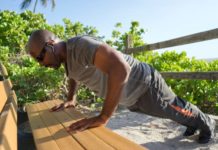
Do You Need to Warm up to Walk?
A pre-workout warmup is important regardless of how hard your workout is — and walking certainly counts as a workout, especially if you’re planning to pick up the pace and do a power walk. A proper warmup can reduce your injury risk, says Jenn Tadashore, a physiotherapist and avid hiker and runner.
“For walking, because you need to be able to move through your hips, you want to have as much range going into the forward step as you have when your leg is at the back,” she says. “So, doing some dynamic stretches to get hips warmed up, get ankles warmed up, and anything that you can do to prepare your muscles and your joints to accept load.”
This is as true if you’re heading out for your power walk you’ve been doing for years as it is if you just started walking for weight loss. “When you’re trying to get a brisk pace going, there is going to be a load that’s transferred each time you take a step, coming up through the foot, the ankle, the knee, the hip into the back,” Tadashore explains.
Even more, warming up with dynamic stretches includes bodyweight strength-training exercises, so you’re toning while warming up to walk, and a few minutes of easy walking to get started before upping the pace is just added time on your feet. All of that extra work adds up over time, leading to big fitness gains.
HOW SHOULD YOU WARM UP?
If you’re going on a leisurely walk, take a couple of minutes to do some of the dynamic stretches listed below to check in with your body and shake things out, especially if you’ve been sitting at a desk all day.
If you’re planning a power walk, start with a few minutes at a relaxed pace before speeding things up, Tadashore says. This helps get the blood flowing and works out any tightness from sitting too long during the day. Once you’ve walked casually for a few minutes, you can steadily start to pick up the pace.
DYNAMIC STRETCHES
Ankle circles: While you don’t need a lot of movement in your ankles when walking normally, if you lose your footing and start to slip or fall, especially on uneven terrain, you want enough mobility in your ankles to handle some sideways motion. You can do ankle circles standing, sitting or lying on your back on the floor.
The move: Simply raise one foot and slowly make a circle with your toes, pointing and flexing around. Do 5 circles in one direction, then 5 in the other direction before switching. To add a bit more challenge, try to write your full name in cursive instead. This forces you to think about where your foot and ankle are in the air in a way that circles won’t!
Walking lunge: Stand up straight, and then take one big step forward with your right foot, and lower your torso toward the ground by bending both knees. You don’t need your back knee to touch the ground; just go down until you feel a stretch in your hip flexors. Rise back up, then step your left foot forward and repeat. Do 5–10 of these on each side to help open up your hips while getting a bodyweight strengthening effect on your quads.
Leg swings: Using a counter or wall, brace your right arm against it for support, then swing your right leg forward and back a few times while balancing on your left leg. This is a great hip opener and great for anyone who finds their hips get tight during a brisk walk. Turn around and brace the wall with your left hand and repeat the process with your left leg.
Gentle upper body stretching: Tadashore recommends moving your upper body a bit before heading out the door, especially if you’ve been at your computer all day. Arm swings and circles are a great way to start to straighten up your posture after being hunched over the laptop, as are a few neck circles and shoulder shrugs. The goal here isn’t to do a specific routine, just to loosen up so your walk feels smooth.
Core work: You don’t have to do core work right before your walk, necessarily, but if you know you’re more likely to get it in during this time versus later in the day, this is a great addition. Do a series of planks (either on the floor in high pushup position or bracing against a counter or sofa if you struggle to hold a plank on the floor), holding the position for a few seconds, then slowly lowering to the ground, resting for a few seconds, then resetting and holding again for 1–2 minutes.
“Having a strong core helps you maneuver through your full range of motion and can help absorb some of that load from walking,” Tadashore adds. A plank is great because it works all of your major muscle groups in your core, and also works your upper back and shoulders.
Check out “Workout Routines” in the MyFitnessPal app to discover and log workouts or build your own with exercises that fit your goals.
































